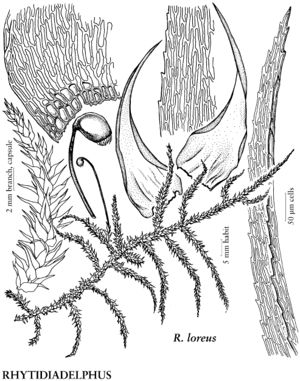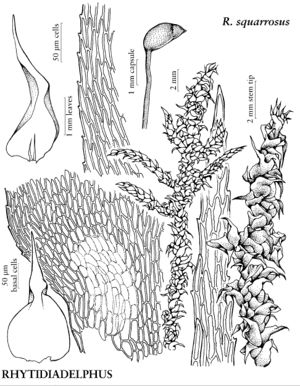Rhytidiadelphus
Krypt.-Fl. Brandenburg 2: 917. 1906.
| Taxon | Illustrator ⠉ | |
|---|---|---|
 | Rhytidiadelphus japonicus | Patricia M. Eckel |
 | Rhytidiadelphus loreus | Patricia M. Eckel |
 | Rhytidiadelphus squarrosus | Patricia M. Eckel |
| ... further results | ||
Stems creeping to ascending or erect, 2–8 mm wide across leafy stem, monopodial, irregularly and remotely branched to subpinnate; paraphyllia absent. Stem-leaves erect-spreading to squarrose, squarrose-recurved, or falcate-secund, crowded or not, broadly ovate, ovate-triangular, or ovatelanceolate, sometimes plicate proximally, sometimes rugose, 2.1–4.9 mm; base not or slightly decurrent; margins serrulate to nearly entire proximally, serrulate distally; apex acuminate; costa double, short or to 2/3 leaf length; alar cells not differentiated, or shorter, wider than basal-cells; laminal cells smooth or coarsely prorate. Branch leaves ovate to narrowly lanceolate. Capsule horizontal; operculum conic; exostome teeth cross-striolate to reticulate; endostome segments broadly perforate.
Distribution
North America, Eurasia, Atlantic Islands, Pacific Islands (New Zealand), Australia (Tasmania), cool temperate and boreal zones
Discussion
Species 5 (5 in the flora).
In recent years, M. S. Ignatov and E. A. Ignatova (2003+, vol. 2) and R. Ochyra and A. Stebel (2008) have advocated placing Rhytidiadelphus triquetrus in its own monospecific genus. Although it is morphologically the most distinctive of the five species of Rhytidiadelphus, evolutionary relationships among the five are not clear. Some molecular studies have suggested a less than close relationship between R. squarrosus and R. triquetrus, but these studies were not directly focused on Hylocomiaceae. On the other hand, the analysis of morphological and anatomical evidence by L. Hedenäs (2004) in his cladistic study of Hylocomiaceae revealed that R. loreus and R. triquetrus share a more recent common ancestor than either does with the other three species. Likewise, ITS and ISSR molecular markers employed by A. Vanderpoorten et al. (2003) delineated two pairs of closely related species: R. loreus with R. triquetrus and R. squarrosus with R. subpinnatus. Until further study clarifies relationships within both Rhytidiadelphus and Hylocomiaceae, it seems best to maintain the traditional circumscription of the genus.
Selected References
None.
Lower Taxa
Key
| 1 | Leaves plicate; alar cells not or slightly differentiated | > 2 |
| 1 | Leaves not plicate; alar cells differentiated | > 3 |
| 2 | Costae 1/2 -2/3 leaf length; medial laminal cells coarsely prorate; stem leaf apices gradually narrowed, acumina broad, flat (occasionally rugose). | Rhytidiadelphus triquetrus |
| 2 | Costae less than 1/4 leaf length; medial laminal cells smooth; stem leaf apices abruptly narrowed, acumina slender, channeled. | Rhytidiadelphus loreus |
| 3 | Costae 1/3-1/2 leaf length; alar cell walls thick, porose; stem leaf acumina short. | Rhytidiadelphus japonicus |
| 3 | Costae to 1/3 leaf length; alar cell walls thin, not porose; stem leaf acumina long | > 4 |
| 4 | Stem leaves not crowded (stem visible between leaves) except at stem apices, erect-spreading to squarrose; bases not or scarcely sheathing; leaves broadly ovate-triangular; stems irregularly branched to pinnate; moist, usually shaded sites. | Rhytidiadelphus subpinnatus |
| 4 | Stem leaves crowded (stem concealed by leaves), strongly squarrose-recurved; bases subsheathing; leaves ovate; stems remotely branched to irregularly pinnate; well-drained, open to partially shaded sites, near coast or in grassy, disturbed habitats. | Rhytidiadelphus squarrosus |
"nearly" is not a number. "single" is not a number."broad" is not a number.